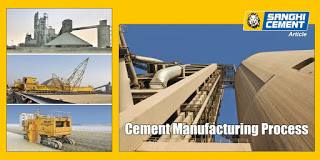Cement Manufacturing Process

Cement manufacturing process involves various raw materials and processes. Cement is a greenish grey coloured powder, made of calcined mixtures of clay and limestone. When mixed with water becomes a hard and strong building material.
It was first introduced by a British stone mason, Joseph Aspdin in 1824, who cooked cement in his kitchen. He heated a mixture of limestone and clay powder in his kitchen, and grind the mixture into powder creating cement, that hardens when mixed with water.
Cement is first used in the tunnel construction in the Thames River in 1828.
Manufacturing Process of Cement
There are four stages in this whole process.
• Mixing of raw material
• Burning
• Grinding
• Storage and packaging
Mixing of raw material
Calcium, Silicon, Iron and Aluminium are the raw materials used majorly in manufacture of cement. There are two methods of mixing. Dry Process and Wet Process.
- Dry Process: The both calcareous and argillaceous raw materials are firstly crushed in the gyratory crushers to get 2-5cm size pieces separately. The crushed materials are again grinded to get fine particles into ball or tube mill. After screening this finely grinded materials are stored in hopper. Then powdered minerals are mixed and dry raw mix is stored in silos and ready to be sent into rotary kiln.
- Wet Process : In this process first raw materials are crushed and made into powdered form and stored in silos. Then clay is washed and sticky organic matters are removed. Then powdered limestone and water washed clay are sent to flow in the channels and transfer to grinding mills where they are completely mixed and the paste is formed. Then grinding process is done in a ball or tube mill or even both. Then the slurry is led into collecting basin where composition can be adjusted. The slurry contains around 38-40% water that is stored in storage tanks and kept ready for the rotary kiln.
Burning of Raw Materials
This process is carried out in rotary kiln while the raw materials are rotated at 1-2rpm at its longitudinal axis. The raw mix of dry process of corrected slurry of wet process is injected into the kiln from the upper end. Powdered coal or oil or hot gases are used to be heated up from the lower end of the kiln so that the long hot flames is produced. The lower part (clinkering zone) have temperature in between 1500-1700 degree Celsius where lime and clay are reacts to yielding calcium aluminates and calcium silicates. This aluminates and silicates of calcium fuse to gather to form small and hard stones are known as clinkers. The size of the clinker is varies from 5-10mm. The clinker coming from the burning zone are very hot. To bring down the temperature of clinkers, air is admitted in counter current direction at the base of the rotary kiln. The cooled clinkers are collected in small trolleys.
Grinding of clinkers
The cooled clinkers are received from the cooling pans and sent into mills. The clinkers are grinded finely into powder in ball mill or tube mill. Powdered gypsum is added around 2-3% as retarding agent during final grinding. The final obtained product is cement that does not settle quickly when comes in contact with water. After the initial setting time of the cement, the cement becomes stiff and the gypsum retards the dissolution of tri-calcium aluminates by forming tricalciumsulfoaluminate which is insoluble and prevents too early further reactions of setting and hardening.
Storage and packaging
The grinded cement is stored in silos, from which it is marketed either in container load or 50kg bags.
………………………………………………………………………………………………………………………………….
Like us on Facebook :- https://www.facebook.com/SanghiCement
Follow us on Linkedin :- https://www.linkedin.com/company/sanghi-industries-ltd
Subscribe us on Youtube :- https://www.youtube.com/SanghiIndustries-Ltd
For any Inquiry visit :- http://www.sanghicement.com/inquiry-form
Contact us on Whatsapp :- +91-79-26838000




